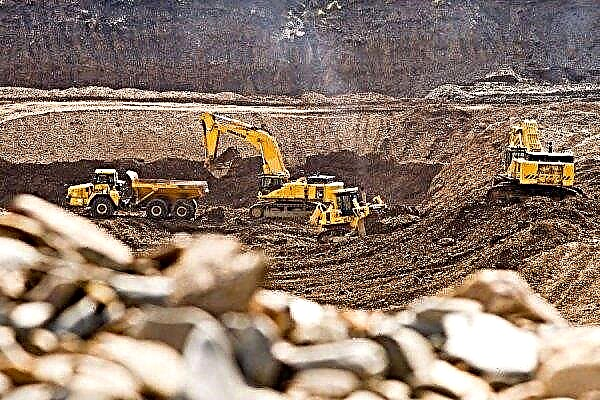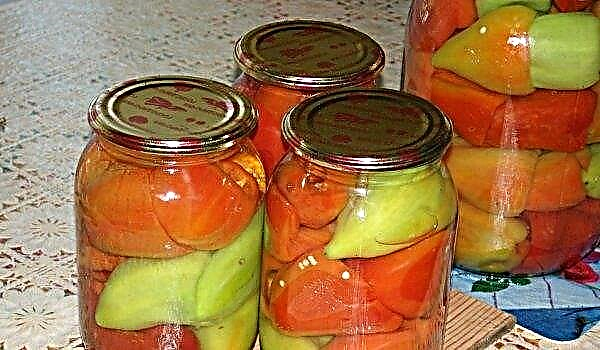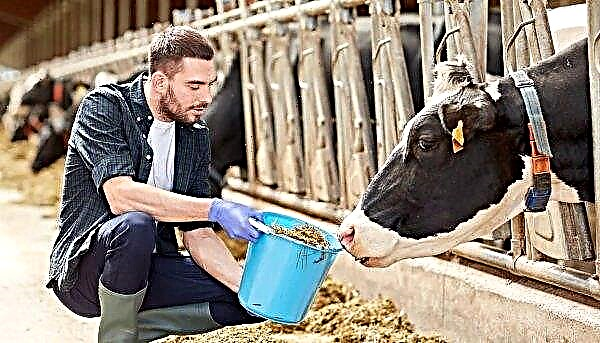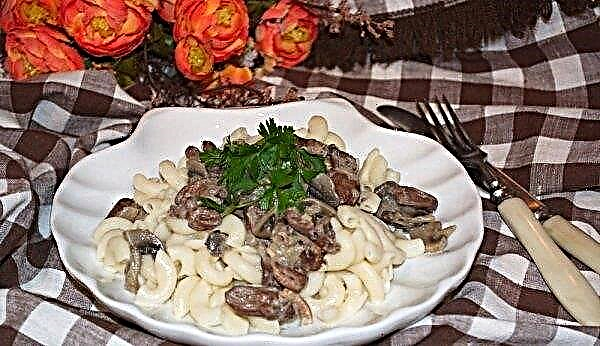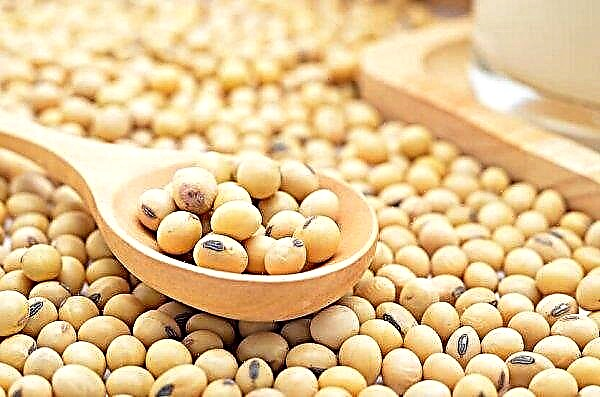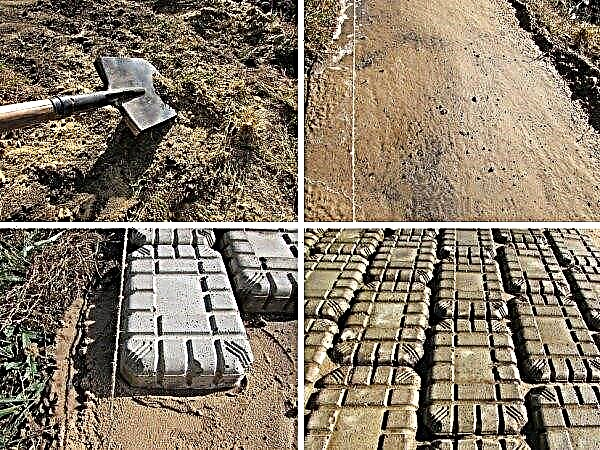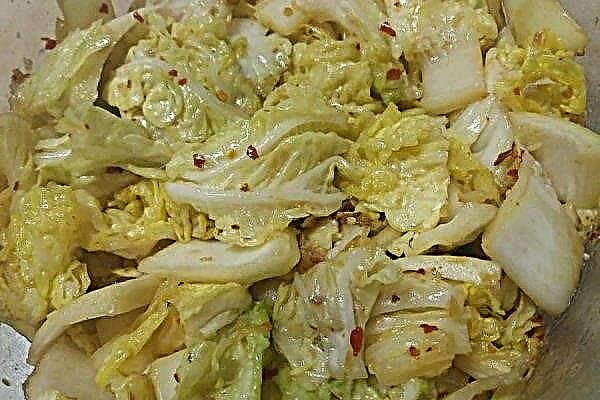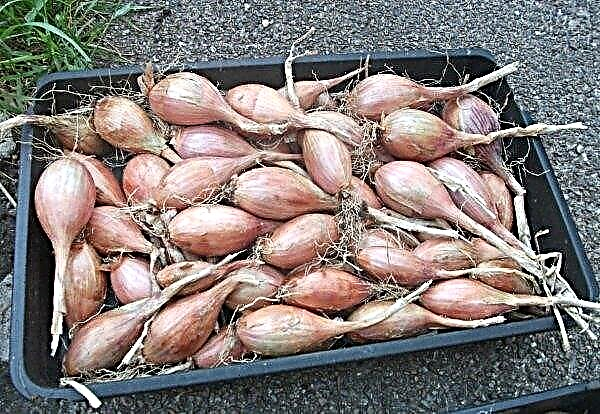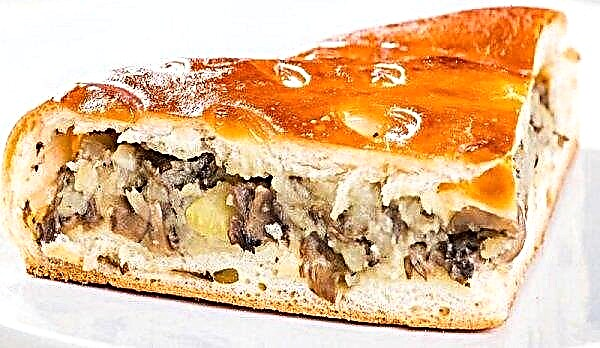In the past few years, the Bamberger variety of onions, which grows from small seeds in the summer into a large commodity bulb, has gained great popularity among gardeners. In this article, we will consider what the Bamberger variety is, how to grow it properly during spring and winter planting, and how to protect a vegetable from pests and diseases.
Important! Experienced vegetable growers recommend cutting the neck of the bulbs before planting the onion sets in the ground using conventional scissors. This agricultural technique will help to sprout bulb leaves without problems.
Description and characteristics of the variety
Onions belong to the family Alliaceae, and is a herbaceous plant cultivated to produce an edible bulb. Juicy onion leaves are also consumed. This is a two-year-old plant, in the first year of cultivation a small bulb (sowing) grows, being planted the next year, the mother bulb throws arrows with inflorescences, which later form black, small seeds. Bamberger is a mid-early variety of Dutch breeding grown from sowing. He won the recognition of gardeners in our country, due to the unpretentiousness of the growing conditions and excellent taste. It has an elongated bulb shape. The diameter and length of an adult onion is about 10 cm, the average weight is 80 g. This shape of the onion is convenient for cooking rings, for making salads or barbecue. Bulb with snow-white juicy pulp, covered with yellow-brown husk.
Bamberger is a mid-early variety of Dutch breeding grown from sowing. He won the recognition of gardeners in our country, due to the unpretentiousness of the growing conditions and excellent taste. It has an elongated bulb shape. The diameter and length of an adult onion is about 10 cm, the average weight is 80 g. This shape of the onion is convenient for cooking rings, for making salads or barbecue. Bulb with snow-white juicy pulp, covered with yellow-brown husk.
Did you know? Onions are rich in flavonoids with a strong antioxidant effect that helps in the treatment of certain types of cancer. Also, the substances contained in the vegetable have a beneficial effect on the body in the treatment of cataracts and cardiovascular diseases.
Advantages and disadvantages
The originators of this variety promise that the Bamberger bulb will survive, almost without loss of juiciness and taste, until spring.
- Positive aspects of the variety:
- has a juicy pulp with a mild taste;
- practically does not shoot;
- suitable for cultivation in various climatic zones;
- possesses high keeping quality;
- has good resistance to onion flies, thrips and diseases such as powdery mildew and bottom rot;
- after long storage does not lose taste.
- The disadvantages of the variety:
- pungent and pungent odor;
- dry husks tend to sprinkle with bulbs during storage.
Optimal growing time
The onion is medium early, so they are not delayed with its landing, trying to hold it early, since the development period of a full onion is a long process. However, planting onions in cold ground is not recommended, this can trigger the release of seed arrows. In the middle lane, the optimal spring landing date is in mid-April. Bamberger can also be planted in the soil in the fall, just before the start of winter. The date of autumn planting is selected so that the bulbs do not have time to germinate, this period usually begins around the third decade of October.
Bamberger can also be planted in the soil in the fall, just before the start of winter. The date of autumn planting is selected so that the bulbs do not have time to germinate, this period usually begins around the third decade of October.
How to grow at home
When growing this crop, it is necessary to observe crop rotation, and do not plant bulbs in the same place for the next 3-4 years. Compliance with crop rotation is necessary in order to reduce the likelihood of harmful pathogens and insect pests appearing onion beds.
Good precursors for onions are peas, soybeans, beets, cabbage or crops, which leave the soil free of weeds. You should pay attention to this, because onions, especially during the emergence of seedlings, are very sensitive to weeds.
Important! Vegetable growers recommend combined planting of onions and carrots, alternating carrots and onions through three rows. During the growing season, volatile carrots scare away the onion fly from the plant neighbor, and the smell of onions masks the planting of carrots from the carrot fly.
Growing conditions
The final result of crop cultivation is influenced by many factors, including: the timing of planting material in the soil, fertilizers, ambient temperature, air and soil humidity.
Soil and fertilizer
This culture develops well in light, permeable, fertile soils. The crumbly structure of the soil creates favorable conditions for seed germination and the proper development of the onion root system. Cultivation should not begin in very acidic or alkaline areas, because this culture is very sensitive to soil acidification. A suitable pH for mineral soils should be between 6.5-7 and for peat soils 5.5-6.5.
Symptoms of unregulated pH that occur during cultivation in acidified areas: suppressed plant growth, small bright green leaves with yellowed tips. For this vegetable, it is extremely important that in the area where the onion bed is located, there is no stagnation of water, which causes rot of the bottom of the bulb. It is better to choose a place for the location of the beds not in the lowlands, but on small hills, well blown by the winds. Onions feel good in sandy soils, naturally pre-seasoned with organic matter. As fertilizer, well rotted cattle manure is suitable. Fertilizing the onion bed with fresh manure is not recommended, as this causes rotting of vegetables during the growing season.
Onions feel good in sandy soils, naturally pre-seasoned with organic matter. As fertilizer, well rotted cattle manure is suitable. Fertilizing the onion bed with fresh manure is not recommended, as this causes rotting of vegetables during the growing season.
After spring plowing or digging, the garden bed can be fed with mineral fertilizers. They are scattered on the surface of the excavated earth, and then they are buried shallow in the ground with a rake. The shallow incorporation of nutrients is due to the fact that the roots of the bulb are rather short, no longer than 6 cm, and they simply will not grow to those located in the deeper layers of nutrition.
Did you know? In order not to cry when slicing onions, housewives with experience recommend holding the vegetable for 15 minutes in the freezer before that.
Preparation of sets
After buying a seed set of Bamberger variety, it is recommended to spread it out for listening in a warm, well-ventilated room. This procedure needs to be set to prevent rotting inside the bulb. The duration of listening varies from 2 to 3 weeks, the optimum temperature at this time is +20 ... + 22 ° C. The day before the start of garden work, the seed material is subjected to heating.
This is a very important agronomic technique for obstructing the shootings of the culture and it contributes to the rapid germination of green leaves and the growth of roots on the bottom. In addition, after heat treatment and subsequent disinfection, spores of fungal diseases, possibly located on the surface of planting material, are destroyed.
How to conduct a long warming of the planting onion:
- Depending on the amount of seeding, choose the appropriate capacity in volume, place the bulbs.
- Water is heated to a temperature of +35 ... + 40 ° C, after which it is poured with hot liquid sevc and the container is closed with a lid.
- To extend the warm-up time, wrap the container well (in an old blanket, plaid), and leave it in this position for 5-6 hours.
- At the end of this time, planting material is ready for planting.
How to conduct a quick warming sevka:
- Planting material is placed in a bucket or pan of a suitable volume, after which it is poured with hot water (+35 ... + 40 ° C) and left under the lid for 15 minutes.
- After 15 minutes, hot water is drained and small onions are poured with cold water for the same period. After this, the onion is ready for planting, but if you wish, you can conduct an additional 15-minute treatment in a growth stimulator (Rost-1, Gumisol) or any liquid mineral complex.
Did you know? Onion cells contain a sulfur-based chemical that irritates the mucous membranes of the eyes and nose of a person. When the hostess slices onions, this substance is released and causes a chemical reaction, which is accompanied by pain in the eyes and causes tears.
If the gardener is not sure that the purchased planting material is healthy, it is most reasonable to treat the seedlings in a dark pink solution of manganese and water. To obtain a working disinfectant solution, about 1 g of potassium permanganate is added to 1 liter of cold water and mixed in a liquid until completely dissolved. Sevc is immersed in a disinfectant solution of manganese for 30 minutes.
A solution of water and copper sulfate can also be used as a disinfection. To do this, add 3 g of copper sulfate to a liter of water, and stir until completely dissolved. Sevc is soaked in a solution of copper sulfate for a period of 20 to 40 minutes, after which, without washing, they are planted in the ground.
Landing technique
Not all gardeners know whether sowing can be planted before winter. It is possible, moreover, such a planting will significantly reduce the spring load on the plant grower.
Onion Bamberger is planted in two terms:
- with the landing of planting material for the winter;
- with spring landing sevka.
Landing under the winter:
- The best time for planting is late autumn, a few weeks before the first minus temperatures. Usually this period begins in the second half of October. It is unacceptable to start onion planting before winter too early (in September or early October), since after an early planting, the bulbs can start to grow, which will significantly reduce their winter hardiness. With prolonged and severe frosts, sprouted bulbs can freeze.
- For planting in the winter, the garden bed is prepared in the same way as in the spring planting (seasoned with organic matter, digging in), but the furrows under the bulbs are made a little deeper than during the spring planting.
- Planting material wintering in the ground should reliably cover a layer of warming soil from frost. The depth of planting furrows from 8 to 10 cm is recommended. The distance between the bulbs in the row is about 10 cm, the distance between the rows is 25-30 cm. The row spacing should be such that when gardening is cultivated, a sharp garden tool will not damage vegetative plants.
- As soon as steady frosts come, a thick layer of mulch is laid on top of the bed with the bulbs planted to warm the plantings. As mulch, you can use: hay, straw, fallen leaves or sawdust. A layer of mulch with a thickness of 10-15 cm is recommended, a thicker shelter can cause the plants to warm up when thaws occur.
- As soon as the snow melts, the mulch layer is immediately removed from the garden. In the normal course of winter, mulch is harvested in the second decade of March, if severe frosts are delayed, the mulch is left until they are finished.
- After the soil on the bed with onions dries, it is necessary to carry out the first loosening. This is a very important event, it allows you to fluff up the caked soil during the winter and saturate the soil with oxygen. Soon after loosening, onion feathers appear from the ground. Further care is identical to spring onion care.
Spring planting:
- They begin to prepare the onion bed as soon as the snow falls and the ground warms up enough. In the northern regions, this time begins approximately in the second decade of April, in the southern regions - in mid-March. The soil on the bed is covered with organic matter at the rate of 10 kg of well-rotted cattle manure per 1 m². If fresh bird droppings are used, it will require much less (200 g per 1 m²), since the nitrogen content in it is much higher, and saturation of the soil with this fertilizer can cause burns on the bulbs.
- Then they dig a garden bed, digging depth - about half a shovel. The excavated earth is leveled with a rake to form the surface of the bed with a slight slope towards the side tracks. This formation of the soil surface will not allow heavy sediment to stagnate in the basal zone, excess moisture flows onto the tracks. The finished bed is marked and planted beards are held. The depth of the planting furrows is from 3 to 5 cm, depending on the size of the bulbs. The optimal size of the bulbs (seed) is from 1 cm to 2 cm. Smaller bulbs can dry during the growing season, and the use of larger ones is unprofitable.
- Half an hour before planting, the furrows are well watered from the calculation: 1 liter of water per 1 meter of furrow length. The row spacing, as during planting before winter, is 25-30 cm. The distance in the row between the plants is 10 cm. This distance is due to the fact that the adult Bamberger bulb has about the same diameter, and the growing plant needs room for growth.

Care Rules
Plants should be properly looked after during the entire growing season: to loosen, feed, protect against diseases and pests, and water. It is proper care that determines the quantity and quality of the grown crop.
Important! It is undesirable to take water directly from the well for watering onions, since its temperature is too low and can cause rotting of the bulbs. Irrigation water should settle and warm to air temperature, so the most successful option is to heat the water in large garden barrels.
Watering rates
Planting should be watered as necessary. Determining whether plants need irrigation is quite simple: if the soil in the bed at a depth of 10 cm is dry and crumbly - watering is needed, if the soil at this depth is still wet - irrigation can be postponed for several days. Watering is carried out in the morning, before the onset of lunch heat. In the evening, watering the onion is undesirable, as it does not have time to dry before sunset. And drops of water on the leaves are an excellent breeding ground for the development of various fungal diseases. Bamberger requires abundant irrigation in the first month of cultivation, a little later, the frequency of irrigation is significantly reduced. Approximately 2 weeks before the expected harvest - soil moisture completely stops.
And drops of water on the leaves are an excellent breeding ground for the development of various fungal diseases. Bamberger requires abundant irrigation in the first month of cultivation, a little later, the frequency of irrigation is significantly reduced. Approximately 2 weeks before the expected harvest - soil moisture completely stops.
Soil cultivation and weeding
Care for planting consists in timely loosening and weeding. They need to be carried out every 10-12 days or more often, as the field is clogged with weeds. Loosening the soil allows you to keep the soil in the aisles clean from weeds, and give it lightness and permeability. After each cultivation of row-spacings, plants grow significantly. For manual weeding, you can use a conventional chopper with a blade of suitable width or a medium-sized plane cutter. If a lot of onions are grown, and a large field is occupied under the growing season, it is advisable to significantly increase the row spacing when planting planting material. It must correspond to the technique (cultivator, tractor), which will cultivate the land.
For manual weeding, you can use a conventional chopper with a blade of suitable width or a medium-sized plane cutter. If a lot of onions are grown, and a large field is occupied under the growing season, it is advisable to significantly increase the row spacing when planting planting material. It must correspond to the technique (cultivator, tractor), which will cultivate the land.
Top dressing
At the stage of the appearance of 4 adult leaves on plants, the bulbs can be fed with nitrogen. For this, you can use nitrogen in granules diluted in water for irrigation or liquid organic fertilizers, such as fermented nettle infusion or chicken droppings.
Important! Chicken manure is a very strong and concentrated fertilizer, so it must first be insisted (half a bucket of manure on half a bucket of water) for a week, after which it should be used only in diluted condition (1:20).
Diseases and Pests
Onion culture is susceptible to many fungal, viral and bacterial diseases. Here are the most dangerous of them:
- Yellow dwarfism - This is a viral disease that appears on the basal leaves in the form of yellow stripes. The affected leaves lie on the ground, and the bulb remains small and does not withstand winter storage. The virus is transmitted from plant to plant aphid. The transmission of the virus from year to year is carried out through infected bulbs. The virus is not transmitted through infected seeds. Prevention and control measures: planting a healthy planting material, the use of insecticides to control the aphid population, elimination of affected plants from the crop. There is no cure.
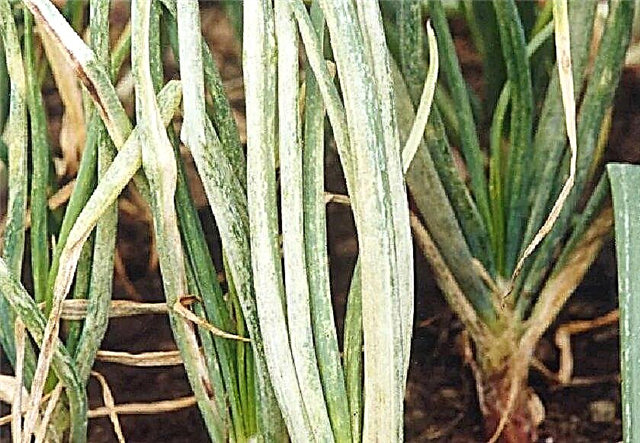
- Bacteriosis - in diseased plants, the stems develop poorly, and at their base moist rot appears, the bulb can completely rot.The disease hibernates in plant debris and spreads through water, wind, people, tools. Prevention and control measures: avoid irrigation by sprinkling; after the first signs of the disease appear, use fungicides (Copernico Hi Bio, Funguran OH 50 WP, Melody Compact 49 WG).
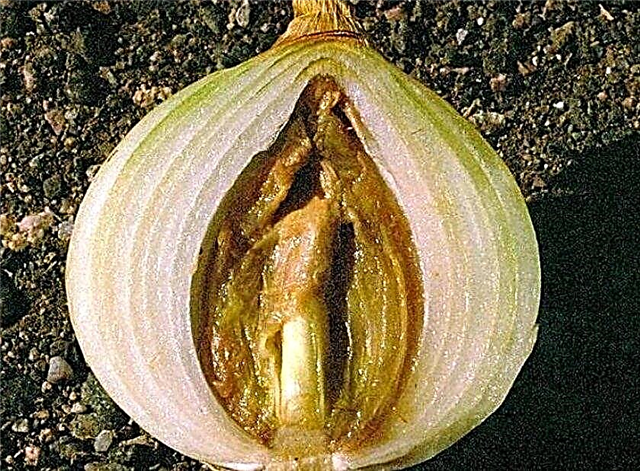
- Peronosporosis - has a fungal nature, the disease affects the bulbs, seed arrows and leaves. The first symptoms appear on the leaves in the form of elongated spots from light green to yellow in color, on which a grayish-purple fluff forms. The affected tissue softens, the sheet dries, falls and rots. The optimal conditions for the occurrence of the disease are high humidity for at least 10 hours and a temperature above +12 ... + 18 ° C. Prevention and control measures: harvesting plant debris from the previous year of cultivation, balanced soil fertilization, proper crop rotation (onions can be planted on the same bed after 3 years), treatment with contact system fungicides (Polyram DF, Dithane M45, Acrobat MZ 90/600 WP ”,“ Aliette 80 WG ”,“ Equation Pro ”,“ Topsin 500 SK ”).

- Botritis - fungal disease, manifested on leaves and bulbs in the form of white spots in which the fabric dries. In humid conditions, gray powder appears in the affected areas. Mature plants may have basal leaf rot with subsequent rotting of the bulbs. Black sclerotia appears in the destroyed places. Transmission occurs through spores of the fungus wintering in the soil or in plant debris. Prevention and control measures: burning or deep stocking of vegetable debris, proper crop rotation and fertilizing, chemical processing during the growing season (“Bravo 500 SC”, “Rovral 500 SC”, “Teldor 500 SC”, “Switch 625 WG”) .
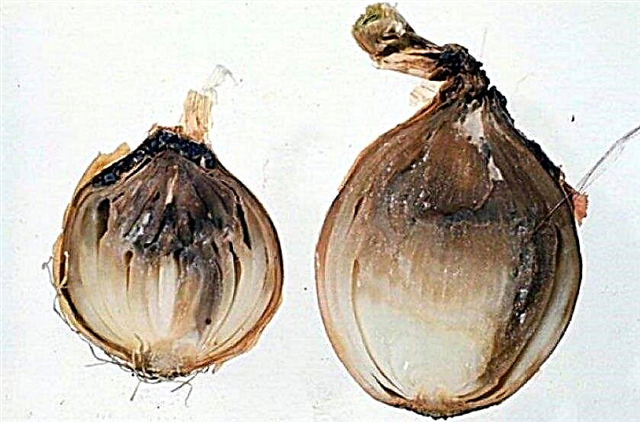
- Fusarium - a fungal disease that affects roots, bulbs or leaves damaged during field work or attacked by pests. The disease is very difficult to detect. Leaves have a slight yellowing in the upper part, and diseased bulbs rot on the bottom, in the root area. Sick roots have white spots, which later turn black, and the root system is destroyed. Prevention and control measures: the cultivation of resistant varieties, the use of healthy planting material, the chemical treatment of plantings with Topsin 70 WDG and Topsin 500 SC. A solution of 0.05-0.1% (5 or 10 g per 10 liters of water) is prepared and each plant is sprayed with 0.5 L (solution).

The most dangerous crop pests:
- Stealthy hunter - larvae and adult insects sit in between the onion leaves. They feed onion juice, causing serious damage to young plants. As prevention and control measures, onion beds are treated with one of the preparations: “Mospilan 20 SG” (1.5 g / 6 l of water), “Actara 25 WG” (0.2 kg / ha), “Confidor Energy” ( 1.3 l / ha), Faster 10 EC (2 ml in 6.6 l of water), Karate Zeon 50 CS.

- Bulb nematode - attacks stems and bulbs. A pest appears in the spring. Nematode infection occurs through soil or infected seeds. In diseased plants, the bulbs remain small, have an irregular shape and cracks. Prevention and control measures: proper crop rotation (in case of infection with the bulb nematode soil, the culture can be returned to the same field after 4 years), removal of diseased plants from the site, cultivation of resistant varieties. Tillage with Force 1.5 G (15 kg / ha) or Basamid Pellets.
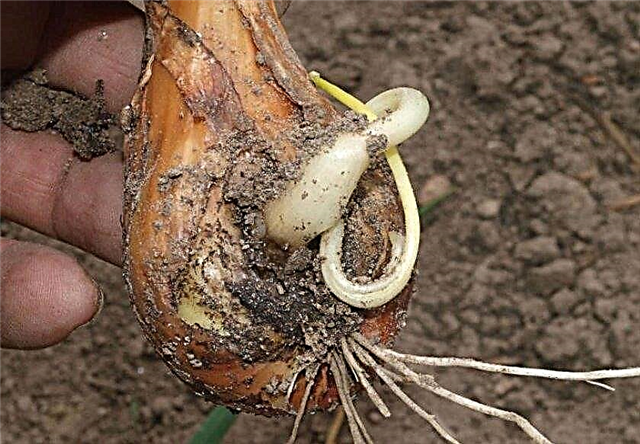
- Onion fly - produces two to three generations a year and feeds on the surface soil layer. In spring, females lay their eggs underground near the onion roots. Larvae enter plant tissues, where they gnaw through many moves during feeding. In case of severe infection by the pest, the plants die. Prevention and control measures: collection and destruction of plant residues after harvesting, processing during the growing season with such preparations: Decis Mega 50, Confidor Energy, Calypso 480 SC, Karate Zeon 50 CS.

Harvesting and storage
When the soil at the base of the plants begins to crack, this indicates that the ripening of the bulbs has begun. From this moment, fertilizer application should be discontinued. This vegetable does not need to be spudded, as the bulbs ripen better if they are on the surface of the soil. When the onion heads ripen, the leaves will begin to turn yellow and fall off. After a few days, the bulbs can be pulled out of the soil and left on the surface so that they begin the hardening process.
Important! A damaged bulb should be eaten immediately, as it will be poorly stored.
After that, the turnip is shaken off the dried earth and transferred for drying for two weeks under a canopy or in a barn. The recommended temperature for storing the Bamberger onion crop varies in the range of +3 ... + 10 ° C, and air humidity within 70%. It is not recommended to mix Bamberger variety with other onion varieties during storage, this can reduce storage time. If there is no special storage for vegetables, then this onion can be successfully stored on the loggia.
Useful Tips
Damage to the bulbs or leaves received during cultivation can provoke the development of certain bacterial diseases. You can reduce the likelihood of such damage by falling asleep on the aisle on the onion bed with natural mulch. As a mulch, a mowed, slightly sunken, grass is suitable. Every two weeks, the mulch layer is renewed, adding new grass, as the previous portion naturally partially decomposes, enriching the soil in the beds with nutrients. The planted bed can be covered with any non-woven material (agrofibre or spanbond). Young plants under cover will be several degrees warmer than in the open. In addition, agrofibre perfectly masks the smell of onion plantings from pests of the crop and reliably covers plants from their invasion.
The planted bed can be covered with any non-woven material (agrofibre or spanbond). Young plants under cover will be several degrees warmer than in the open. In addition, agrofibre perfectly masks the smell of onion plantings from pests of the crop and reliably covers plants from their invasion.
Did you know? During viral epidemics, onions are widely used due to its antiseptic properties.
Onions can be grown under this light shelter throughout the growing season, removing it only for weeding. They do not remove spanbond for watering, it perfectly passes water through itself. Knowing the planting dates and the rules for caring for Bamberger onions, both a novice and an experienced gardener will be able to grow an excellent crop of large and juicy bulbs without problems.









